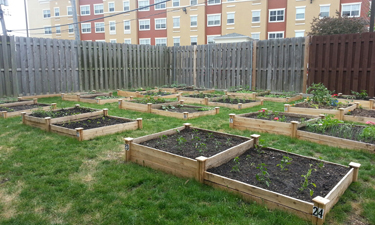 In the Village of Rosemont, Illinois, there was once a gravel lot — think tiny stones worn down and ground up from car tires, dust and dirt when dry, mud and puddles when wet, and not a single blade of green outside of maybe an errant weed or two. On this side of the village, there is little to no green space.
In the Village of Rosemont, Illinois, there was once a gravel lot — think tiny stones worn down and ground up from car tires, dust and dirt when dry, mud and puddles when wet, and not a single blade of green outside of maybe an errant weed or two. On this side of the village, there is little to no green space.
But Omar Camarillo and Karen Stephens of the Rosemont Park District knew this lot had potential for their low-income community of less than 10,000. And one day their answer came — a community garden.
After Stephens spotted the announcement of a community garden grant opportunity through NRPA and the Darden Foundation, she immediately picked up the phone and called Camarillo to encourage him to apply for the grant. He agreed, and they were soon selected to receive a Grow Your Park Grant.
The two quickly got to work revamping and transforming the lot into a suitable gardening space, laying down seed, growing lush green grass and obtaining gardening supplies such as an outdoor gardening box that they filled with gloves, shovels and other tools. They also informed the community of the opportunity to claim one of the 24 available garden boxes. Word spread quickly around the village, and 24 families soon signed up, claiming each plot.
The Village of Rosemont, a suburb of Chicago positioned between O’Hare International Airport and the Chicago Loop, is about 95 percent Hispanic. Culture and heritage definitely factored into the acceptance of a community garden.
“In the communities these families come from in Mexico, gardening is a significant part of the culture,” explains Camarillo, a lifelong resident of Rosemont and the director of Rosemont Recreation Center. “These community gardening plots enable families to pass on traditions to the younger generation while also giving them the fresh produce they need. I see younger kids out here tending to the plots with their grandparents — it really is bringing the community together.”
As part of the program, families will donate a portion of their crops to a local charity to help other area families in need. The gardeners all wholeheartedly agreed to the donation and were more than happy to share their bounty.
While still early on in the process, the garden is a classic example of how one small park and recreation department is making a huge impact in improving quality of life — from health and wellness to conservation to social equity — this garden has it all.
Lauren Hoffmann is NRPA’s Senior Public Relations and Communications Manager.
From Gravel Lot to Garden of Possibilities
July 1, 2013, Department, by Lauren Hoffmann

